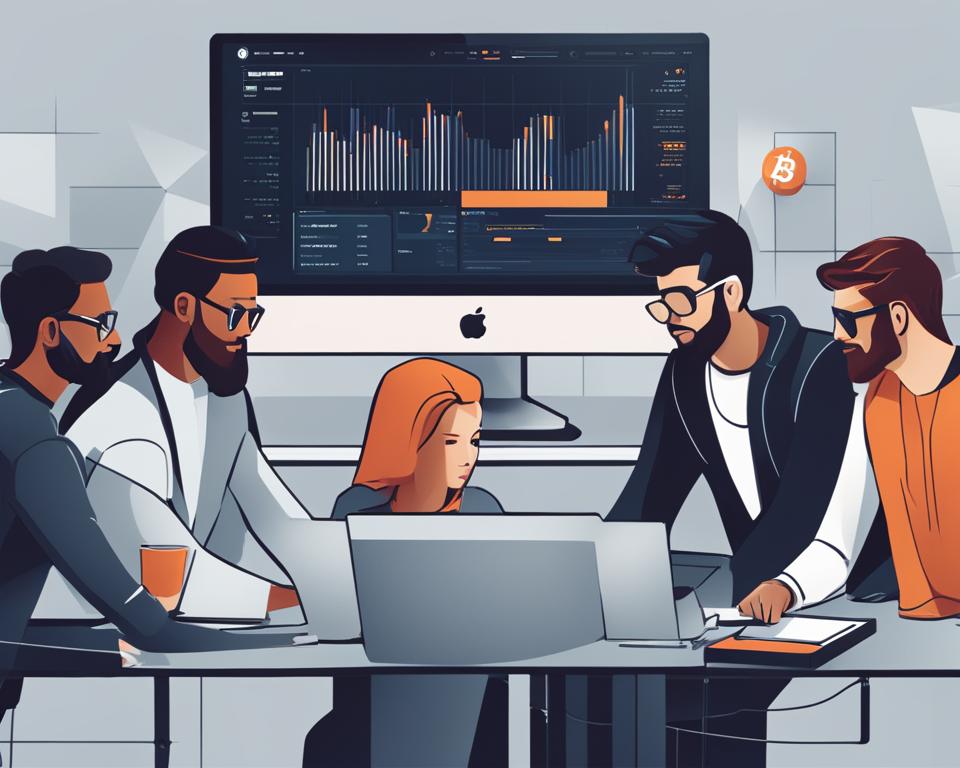Adverts
In this practical guide, you will learn how to mine Bitcoin efficiently. Discover the best strategies and the right hardware to optimize your earnings on crypto market.
Main points covered in this practical guide:
- Understand the concept of Bitcoin mining and how it works
- Discover the three main ways to mine Bitcoin: pool mining, solo mining It is cloud mining
- Follow a tutorial step by step for mine Bitcoin in a pool, from equipment setup to profit calculation
- Explore alternatives viable for mine Bitcoin at home taking into account the costs involved
- Evaluate the advantages and disadvantages of Bitcoin mining before starting on crypto market
A Bitcoin mining can be a great way to make a profit, but it is important to understand the process behind it and consider the costs involved. Keep reading to learn everything you need to know to mine Bitcoin with efficiency.
Adverts
Main points covered in this practical guide:
- Understand the concept of Bitcoin mining and how it works
- Discover the three main ways to mine Bitcoin: pool mining, solo mining It is cloud mining
- Follow a tutorial step by step to mine Bitcoin in a pool, from setting up the equipment to calculating profits
- Explore alternatives viable for mine Bitcoin at home taking into account the costs involved
- Evaluate the advantages and disadvantages of Bitcoin mining before starting in crypto market
What is Bitcoin Mining and How Does It Work?
Bitcoin mining involves validating transactions and securing the network by solving complex mathematical equations. Miners compete to solve these equations and, when successful, are rewarded with new bitcoins. This process is called proof-of-work (proof of work) and is essential to maintain the operation from the blockchain of Bitcoin.
In Bitcoin mining, miners use powerful computers to perform complex mathematical calculations. These calculations are necessary to verify and validate transactions made on the network. Each transaction is grouped into a block, and miners compete to solve a mathematical problem, known as hash. The miner who finds the solution first has the right to add the block to the blockchain and receive a reward in bitcoins.
Adverts
This process of resolving hash It is known as proof-of-work (proof of work), as miners need to prove that they have performed significant computational work to validate transactions.
“Bitcoin mining is essential to guarantee the security and immutability of blockchain of Bitcoin. By solving complex mathematical problems, miners are contributing to the maintenance and integrity of the network.”
How does Proof-of-Work work?
O proof-of-work is based on a function hash cryptographic, which transforms a set of data into a unique and fixed result. In this process, miners need to find a hash value that meets certain pre-established criteria. These criteria are related to the difficulty of the mathematical problem to be solved.
To find the correct hash value, miners use the processing power of their computers. They perform millions of calculations per second, changing small parts of the data until they reach the desired value. This is a process that requires a lot of computational power and consumes a lot of energy.
Once a miner finds a hash value that meets the problem's criteria, it adds it to the block of transactions and publishes it to the network. Other miners then verify and validate the block, ensuring that all transactions are legitimate. After validation, the block is added to the blockchain and miners are rewarded with new bitcoins.
The Bitcoin mining process is continuous and the difficulty of mathematical problems is automatically adjusted by the network to keep the average time to create a new block at approximately 10 minutes. This ensures network security and prevents mining that is too fast or too slow.
Why is Mining Important?
Bitcoin mining is fundamental to the operation network and transaction security. It ensures that transactions are verified and added to the blockchain in a reliable and immutable way. Without mining, the Bitcoin network would be vulnerable to attacks and manipulations.
Furthermore, Bitcoin mining is also a means of distributing new bitcoins to the market. With each new block added to the blockchain, a fixed amount of bitcoins is generated and rewarded to miners. This encourages participation in the network and helps maintain cryptocurrency liquidity.
In summary, Bitcoin mining is a complex and essential process for the operation from the Web. It involves solving mathematical problems, validating transactions and distributing new bitcoins. Through proof-of-work, miners guarantee the security and integrity of the Bitcoin blockchain.
The Three Ways to Mine Bitcoin
There are three main ways to mine Bitcoin: pool mining, The solo mining and the cloud mining. Each of these approaches has its advantages and disadvantages, and it is important to understand their characteristics before deciding which option is best for you.
Pool mining is a popular way of mining bitcoin in which multiple miners come together to combine their resources and increase the chances of finding a block. In this method, gains are shared among members in proportion to their processing power contribution. This approach reduces reward variations and allows miners with less powerful hardware a better chance of achieving consistent gains.
On the other hand, solo mining involves the operation of a single miner, who uses his own hardware to solve mathematical equations and validate transactions on the Bitcoin blockchain. In this method, the miner keeps all the rewards if they are successful in finding a block, but the probability of finding a block alone is lower, making solo mining a riskier and more unpredictable option.
Cloud mining is an alternative for those who want to mine Bitcoin without the need to purchase and configure specialized hardware. In this method, users can rent processing power in remote data centers, carrying out mining virtually, over the internet. While this approach offers convenience and is affordable for beginners, it is important to choose a reliable provider and evaluate the costs involved.
Choosing the best way to mine Bitcoin depends on several factors, including investment level, technical knowledge, hardware availability, and risk tolerance. It is recommended to research and compare the advantages and disadvantages of each method before starting mining.
Advantages and Disadvantages of Three Ways of Mining Bitcoin
| Mining Method | Benefits | Disadvantages |
|---|---|---|
| Pool Mining | – Greater probability of frequent wins – Reduction in reward variations – Possibility of participation with less powerful hardware |
– Need to trust the mining pool – Less control over the mining process |
| Solo Mining | – Possibility to earn all rewards if you find a block – Greater control over the mining process |
– Less likely to find a block alone – More pronounced reward variations |
| Cloud Mining | – Convenience of not having to purchase your own hardware – Access to greater processing capacity – Easy for beginners |
– Need to choose a reliable provider – Ongoing rental costs |
How to Mine Bitcoin in a Pool: Step-by-Step Tutorial
If you opt for pool mining, this step by step tutorial will guide you from equipment configuration until choosing the mining pool and the calculation of expected profits. You will learn how configure your mining rig, choose one trusted pool, check how much you have mined and calculate the potential earnings.

Configuring the Equipment
Before starting pool mining, you will need to properly configure your equipment. Follow these steps:
- Check that your mining equipment is working properly.
- Connect the equipment to a suitable computer or device.
- Install the mining software recommended by the manufacturer.
- Configure mining options according to your preferences.
Once your rig is set up, you are ready to choose a mining pool.
Choosing the Mining Pool
Choosing a mining pool is an important step to ensure an efficient process and stable earnings. Consider the following aspects when choosing a pool:
- Pool reputation and history.
- Pool payment fees and policies.
- Pool returns and stability.
- Pool support and community.
It is recommended to research and compare different pools before making a decision.
Checking Your Earnings
Once you start mining in a pool, it is important to closely monitor your earnings. Most pools offer a user interface that allows you to check mining statistics and progress. Be sure to keep track of the following:
- The total bitcoin mined.
- The pool's hash rate.
- The number of shares submitted.
- Payments received or expected.
Keep accurate, up-to-date records to monitor your performance and make adjustments if necessary.
Calculating your Profits
To understand your potential profits from pool mining, you will need to calculate the earnings based on the statistics provided by the pool. Use the following information:
Total bitcoin mined: X BTC
Pool hash rate: X TH/s
Block reward: X BTC
Pool payout rate: X%
Based on these numbers, you can use an online mining calculator to estimate your daily, weekly or monthly profits. This calculation will help you make informed decisions about your pool mining activity.
| Date | Daily Earnings (BTC) | Weekly Earnings (BTC) | Monthly Earnings (BTC) |
|---|---|---|---|
| 01/01/2022 | 0.01 | 0.07 | 0.3 |
| 02/01/2022 | 0.012 | 0.084 | 0.36 |
| 03/01/2022 | 0.009 | 0.063 | 0.27 |
The values in the table above are illustrative only and may vary based on the pool's hash rate, bitcoin price and other factors. Remember to consider these variables when making your own profit calculations.
Alternatives to Mining Bitcoin at Home
While mining Bitcoin at home has been a common practice in the past, it is becoming less and less viable today. The high costs of electrical energy and the investment in specialized equipment required to mine Bitcoin at home can make it difficult to make significant profits. Furthermore, the increasing difficulty and competition on the network also impacts the profitability of mining at home.
However, there are alternatives that cryptocurrency enthusiasts can consider when looking to mine Bitcoin. Below are some viable and more affordable options:
- Pool Mining: Joining a mining pool allows miners to share resources and processing power, increasing the chances of successful block resolution. When joining a pool, equipment and energy costs are shared among participants, making mining more affordable and potentially more profitable.
- Cloud Mining: Cloud mining involves renting processing power from specialized companies, which operate data centers dedicated to cryptocurrency mining. This option eliminates the need to purchase and maintain your own hardware, significantly reducing upfront costs. However, it is important to research and choose reliable suppliers before investing in this alternative.
- Investing in Bitcoin: Another alternative to obtaining Bitcoin is to invest directly in the currency through trading platforms. This option eliminates the need for mining, but requires market knowledge and careful analysis to make informed investment decisions. It is worth noting that investments are subject to risks and volatility.
When considering these alternatives, it is important to evaluate the costs involved, the viability of the process and the potential financial return. Each option has its own advantages and disadvantages, so it is essential to conduct thorough research and make informed decisions based on your needs and goals.
In order to more clearly visualize the alternatives for mining Bitcoin at home, we present a comparative table below:
| Alternative | Costs | Difficulty level | Profit Potential |
|---|---|---|---|
| Pool Mining | Moderate – costs shared between participants | Average | Varies depending on pool performance |
| Cloud Mining | Reasons – rental of processing power | Low | Dependent on contract and currency appreciation |
| Investing in Bitcoin | Varies depending on the desired investment amount | AT | Dependent on currency appreciation and purchase/sale timing |
Remember that Bitcoin mining is a process that involves risks and uncertainties. Before making any decision, it is recommended to carry out additional research, consult specialized professionals and consider your investor profile. Carefully evaluate the available alternatives for mining Bitcoin at home and find the best strategy that meets your needs and financial goals.

Conclusion
Bitcoin mining can be a profitable activity if done correctly, with the right hardware and solid financial planning. However, it is important to consider the costs involved and the alternatives available before starting mining. Evaluate your options and make an informed decision to make the most of the crypto market.
Although Bitcoin mining is a way to earn passive income, it is crucial to understand that electricity costs and the price of equipment can affect your profits. Furthermore, it is essential to be aware of existing alternatives, such as pool mining or cloud mining, which can reduce costs and increase profitability. efficiency.
Remember that the crypto market is volatile and subject to significant price fluctuations. Therefore, it is important to follow market trends and adapt to changes. Consulting trusted sources and joining active mining communities can also be a great way to get up-to-date information and valuable tips to maximize your earnings.
In short, Bitcoin mining can be an exciting opportunity to participate in the crypto market and earn significant profits. However, it is essential to be well prepared, carry out adequate research and consider all variables before embarking on this journey. With the right knowledge and the right strategy, you will be well equipped to face the challenges and make the most of the opportunities offered by Bitcoin mining.
FAQ
What is Bitcoin mining?
Bitcoin mining involves validating transactions and securing the network by solving complex mathematical equations. Miners compete to solve these equations and, when successful, are rewarded with new bitcoins. This process is called proof-of-work and is fundamental to keeping the Bitcoin blockchain functioning.
What are the three main ways to mine Bitcoin?
The three main ways to mine Bitcoin are: pool mining, solo mining and cloud mining. Each of these approaches has its advantages and disadvantages, and it is important to understand their characteristics before deciding which option is best for you.
How to mine Bitcoin in a pool?
If you opt for pool mining, this tutorial step by step will guide you from setting up the equipment to choosing the mining pool and calculating expected profits. You will learn how to set up your mining rig, choose a reliable pool, check how much you have mined and calculate potential earnings.
What are the alternatives to mining Bitcoin at home?
Mining Bitcoin at home has become less and less viable due to the high costs of energy and specialized equipment required. In this section, we will explore some alternatives for mining Bitcoin, taking into account the costs involved and the viability of the process.
Is Bitcoin mining a profitable activity?
Bitcoin mining can be a profitable activity if done correctly, with the right hardware and solid financial planning. However, it is important to consider the costs involved and the alternatives available before starting mining. Evaluate your options and make an informed decision to make the most of the crypto market.


